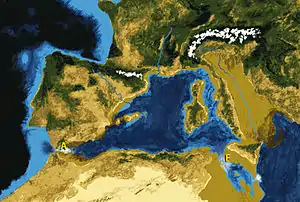Zanclean
The Zanclean is the lowest stage or earliest age on the geologic time scale of the Pliocene. It spans the time between 5.332 ± 0.005 Ma (million years ago) and 3.6 ± 0.005 Ma. It is preceded by the Messinian Age of the Miocene Epoch, and followed by the Piacenzian Age.
| Zanclean | |||||||||||
|---|---|---|---|---|---|---|---|---|---|---|---|
| Chronology | |||||||||||
| |||||||||||
| Formerly part of | Tertiary Period/System | ||||||||||
| Etymology | |||||||||||
| Name formality | Formal | ||||||||||
| Usage information | |||||||||||
| Celestial body | Earth | ||||||||||
| Regional usage | Global (ICS) | ||||||||||
| Time scale(s) used | ICS Time Scale | ||||||||||
| Definition | |||||||||||
| Chronological unit | Age | ||||||||||
| Stratigraphic unit | Stage | ||||||||||
| Time span formality | Formal | ||||||||||
| Lower boundary definition | Base of the Thvera magnetic event (C3n.4n), which is only 96 ka (5 precession cycles) younger than the GSSP | ||||||||||
| Lower boundary GSSP | Heraclea Minoa section, Heraclea Minoa, Cattolica Eraclea, Sicily, Italy 37.3917°N 13.2806°E | ||||||||||
| Lower GSSP ratified | 2000[4] | ||||||||||
| Upper boundary definition | Base of Gauss/Gilbert (C2An/C2Ar) magnetic reversal | ||||||||||
| Upper boundary GSSP | Punta Piccola Section, Porto Empedocle, Sicily, Italy 37.2889°N 13.4933°E | ||||||||||
| Upper GSSP ratified | January 1997[5] | ||||||||||

The Zanclean can be correlated with regionally used stages, such as the Opoitian of New Zealand,[6] and the Tabianian or Dacian of Central Europe. It also corresponds to the late Hemphillian to mid-Blancan North American Land Mammal Ages. In California, the Zanclean roughly corresponds to the middle part of the Delmontian stage.[7]
Definition
The Zanclean Stage was introduced by Giuseppe Seguenza in 1868. It is named after Zancle, the pre-Roman name for the Italian city of Messina on Sicily.
The base of the Zanclean (and the Pliocene Series) lies with the top of magnetic chronozone Cr3 (about 100,000 years before the Thvera normal subchronozone C3n.4n). The base is also close to the extinction level of the calcareous nanoplankton species Triquetrorhabdulus rugosus (the base of biozone CN10b) and the first appearance of nanoplankton Ceratolithus acutus. The GSSP for the Zanclean is in the vicinity of the ruins of the ancient city of Heraclea Minoa on Sicily, Italy.[4]
The top of the Zanclean Stage (the base of the Piacenzian Stage) is at the base of magnetic chronozone C2An (the base of the Gauss chronozone and at the extinction of the planktonic forams Globorotalia margaritae and Pulleniatina primalis.
Events of the Zanclean
- The Zanclean flood marked the beginning of the age and the end of the Messinian, as water poured in from the Atlantic Ocean through the Strait of Gibraltar to deluge the Mediterranean Basin and end the Messinian salinity crisis, a period about 5.96 Ma ago in the Messinian Age of the Miocene Epoch when the Mediterranean Sea had evaporated partly or completely.[8]
- Deposits in the Everglades were deposited when high tropical water started to return in the late Zanclean.[9]
References
Notes
- Krijgsman, W.; Garcés, M.; Langereis, C. G.; Daams, R.; Van Dam, J.; Van Der Meulen, A. J.; Agustí, J.; Cabrera, L. (1996). "A new chronology for the middle to late Miocene continental record in Spain". Earth and Planetary Science Letters. 142 (3–4): 367–380. Bibcode:1996E&PSL.142..367K. doi:10.1016/0012-821X(96)00109-4.
- Retallack, G. J. (1997). "Neogene Expansion of the North American Prairie". PALAIOS. 12 (4): 380–390. doi:10.2307/3515337. JSTOR 3515337. Retrieved 2008-02-11.
- "ICS Timescale Chart" (PDF). www.stratigraphy.org.
- Van Couvering, John; Castradori, Davide; Cita, Maria; Hilgen, Frederik; Rio, Domenico (September 2000). "The base of the Zanclean Stage and of the Pliocene Series" (PDF). Episodes. 23 (3): 179–187. doi:10.18814/epiiugs/2000/v23i3/005. S2CID 10836910.
- Castradori, D.; D. Rio; F. J. Hilgen; L. J. Lourens (1998). "The Global Standard Stratotype-section and Point (GSSP) of the Piacenzian Stage (Middle Pliocene)" (PDF). Episodes. 21 (2): 88–93. doi:10.18814/epiiugs/1998/v21i2/003. Retrieved 26 December 2020.
- Gradstein FM, Ogg JG, Schmitz MD, Ogg GM, eds. (2012). The Geologic Timescale 2012. Elsevier. pp. 936–937. ISBN 978-0-44-459390-0.
- Allaby, Ailsa; Michael Allaby (1999). "Delmontian". A Dictionary of Earth Sciences. Encyclopedia.com. Retrieved 10 Dec 2009.
A stage in the Upper Tertiary of the west coast of N. America
- Marco Roveri; Adele Bertini; DomenicoCosentino; Agata Di Stefano; Rocco Gennari; Elsa Gliozzi; Francesco Grossi; Silvia Maria Iaccarino; Stefano Lugli; Vinicio Manzi; Marco Tavian (2008). "A high-resolution stratigraphic framework for the latest Messinian events in the Mediterranean area" (PDF). Stratigraphy. 5 (3–4): 323–342, text-figures 1-9. Archived from the original (PDF) on January 21, 2012. Retrieved December 10, 2009.
- Petuch, Edward J.; Roberts, Charles (18 April 2007). The Geology of the Everglades and Adjacent Areas. ISBN 9781420045598.
Literature
- Castradori, D.; Rio, D.; Hilgen, F.J. & Lourens, L.J.; 1998: The Global Standard Stratotype section and Point (GSSP) of the Piacenzian Stage (Middle Pliocene), Episodes, 21(2): pp 88–93.
- Gradstein, F.M.; Ogg, J.G. & Smith, A.G. (eds.) (2005) A Geologic Time Scale 2004 Cambridge University Press, Cambridge, UK, ISBN 0-521-78142-6.
- Giuseppe Seguenza; 1868: La Formation Zancléenne, ou recherches sur une nouvelle formation tertiaire, Bulletin de la Société Géologique de France, séries 2, 25: 465-485. (in French)
- Van Couvering, J.A.; Castradori, D.; Cita, M.B.; Hilgen, F.J. & Rio, D.; 2000: The base of the Zanclean Stage and of the Pliocene Series, Episodes, 23(3): pp 179–187.
External links
- Zanclean at the GeoWhen database
- Neogene timescale, at the website of the subcommission for stratigraphic information of the ICS
- Neogene timescale at the website of the Norwegian network of offshore records of geology and stratigraphy